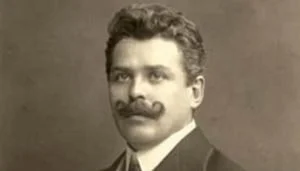Jan Janský was born in Prague in 1873. He received his medical degree from Charles University. After graduation, Janský became a non-resident physician at the First Medical Clinic. Later, he became an assistant professor. In 1914, He was made “Professor Extraordinaire and deputy head physician of the Psychiatry Department.” In Prague, he became the head physician of the Department of Neurology and Forensic Psychiatry at the Military Hospital. He was the first in the Czech Republic to perform serology (testing of blood serum) testing on cerebral spinal fluid.
Jan Janský discovered the four known blood types (I, II, III, VI). I (O), II (A), III (B), IV (AB). After he died, his discovery surfaced. He does not get much credit for his discovery. Karl Lansteiner discovered the ABO blood system and won a Nobel prize for it in 1930. Lansteiner failed to discover the AB blood type that Jan Janský found later. Lansteiner and Janský were studying serology around the same time. Landsteiner just put his research out first. Blood types are an important discovery because giving someone the wrong type of blood in a blood transfusion can kill them. A does not mix with B or AB. O does not mix with A, B, or AB. O- is called the ‘universal donor’ because any blood type can receive O- blood. AB+ is the ‘universal recipient’ because AB+ blood can receive any blood. The most common blood type is O+, while the least common blood type is AB-.
Having opposite blood types can cause issues. Sometimes, babies are born with positive or negative blood types while their mothers are the opposite, leading to Rh disease. Rh is what makes a blood type positive or negative. Rh disease can cause fetal anemia, swelling, and other symptoms that are harmful to babies. Babies grow inside the mother, get nutrients from them, and share blood through the umbilical cord, which can cause issues when they do not share the same Rh factor. Rh disease can be prevented if caught early. Blood type incompatibility can be tested by ultrasound, blood tests, and samples from the fetal umbilical cord. The incompatibility tests are looking for fetal anemia and fluid buildup.
While Rh disease is a problem, the amount of blood donations in the United States is too. The United States needs donations for cancer patients, organ transplants, injuries like car crashes, and more. The most highly demanded blood type is type O because many people are O+ and O- can be given to everyone. Blood drives are easily accessible, with them being at donation centers, schools, and sometimes in a travel van. Someone requires blood every two seconds. The Red Cross is facing its lowest number of blood donations in twenty years.
Without Jan Janský’s discovery, we would not know enough about blood. Janský made an advanced contribution to the medical world for his time because blood types are a vital part of medicine. Without the knowledge of AB blood, there would be a lot at stake. We would not be where we are in medicine without his discovery.
Sources
Blood and Transplant, NHS. “O Negative Blood Type.” NHS Blood Donation, www.blood.co.uk/why-give-blood/blood-types/o-negative-blood-type/#:~:text=O%20negative%20donors%20are%20often,requests%20for%20red%20blood%20cells. Accessed 6 Feb. 2024.
“Blood Type Incompatibility.” Blood Type Incompatibility | Children’s Wisconsin, childrenswi.org/medical-care/fetal-concerns-center/conditions/pregnancy-complications/blood-type-incompatibility#:~:text=Every%20person%27s%20blood%20has%20certain,also%20known%20as%20Rh%20incompatibility). Accessed 6 Feb. 2024.
Farr, A D. Blood Group Serology-the First - Four Decades (1900-1939), www.ncbi.nlm.nih.gov/pmc/articles/PMC1082436/pdf/medhist00099-0101.pdf. Accessed 6 Feb. 2024.
Google Search, Google, www.google.com/search?sca_esv=5ee345275e04b3bb&q=rh%2Bdisease&tbm=isch&source=lnms&prmd=ihvnsmbt&sa=X&ved=2ahUKEwiJqf3X1peEAxW1ITQIHWfTC7MQ0pQJegQIEhAB&biw=1552&bih=744&dpr=1#imgrc=h2oSeYNDDCYbdM. Accessed 6 Feb. 2024.
Gáfriková, Eliška. “Zachránil Tisíce Lidí, Uznání Se Nedočkal. Janský Krevní Skupiny Objevil Náhodou.” Deník.Cz, 3 Apr. 2023, www.denik.cz/z_domova/jan-jansky-krevni-skupiny.html.
Hladík, Martin. “Forgotten Czechs – Jan Jánský.” Czech & Slovak Leaders, 12 Oct. 2022, www.czechleaders.com/posts/forgotten-czechs-jan-jansky.
Medicine, Penn. “The Connection between Blood Type and Heart Health.” Penn Medicine, www.pennmedicine.org/news/news-blog/2018/february/the-connection-between-blood-type-and-heart-health. Accessed 6 Feb. 2024.
Mitra, Ranadhir, et al. “Blood Groups Systems.” Indian Journal of Anaesthesia, U.S. National Library of Medicine, Sept. 2014, www.ncbi.nlm.nih.gov/pmc/articles/PMC4260296/#:~:text=Karl%20Landsteiner%20has%20been%20credited,testing%2C%20and%20subsequent%20transfusion%20practices.
Mole, sara, et al. “The Neuronal Ceroid Lipofuscinoses (Batten Disease).” Google Books, Google, books.google.com/books?id=iViwAAAAQBAJ&dq=%22Hematological%2Bstudy%2Bof%2Bpsychotics%22%2BJan%2BJansk%C3%BD&pg=PA12#v=onepage&q=%22Hematological%20study%20of%20psychotics%22%20Jan%20Jansk%C3%BD&f=false. Accessed 6 Feb. 2024.
Plasma, Biopharma. “Blood Types and Rh Factor: Biopharma Plasma.” Biopharma Plasmacenters, biopharmaplasma.ua/en/news/vse-shcho-ti-ne-znav-pro-svoyu-grupu-krovi. Accessed 6 Feb. 2024.
professional, Cleveland Clinic medical. “Blood Types: Differences, Rarity and Compatibility.” Cleveland Clinic, my.clevelandclinic.org/health/treatments/21213-blood-types. Accessed 6 Feb. 2024.
“Red Cross Declares Emergency Blood Shortage, Calls for Donations during National Blood Donor Month.” American Red Cross, www.redcross.org/about-us/news-and-events/press-release/2024/red-cross-declares-emergency-blood-shortage-calls-for-donations-during-national-blood-donor-month.html. Accessed 6 Feb. 2024.
Ridley, Alexia. “Red Cross Encourages Donating Blood before ‘national Volunteer Month’ Ends.” WUGA, WUGA, 27 Apr. 2021, www.wuga.org/local-news/2021-04-27/red-cross-encourages-donating-blood-before-national-volunteer-month-ends.
Written by: Mikayla Faires





